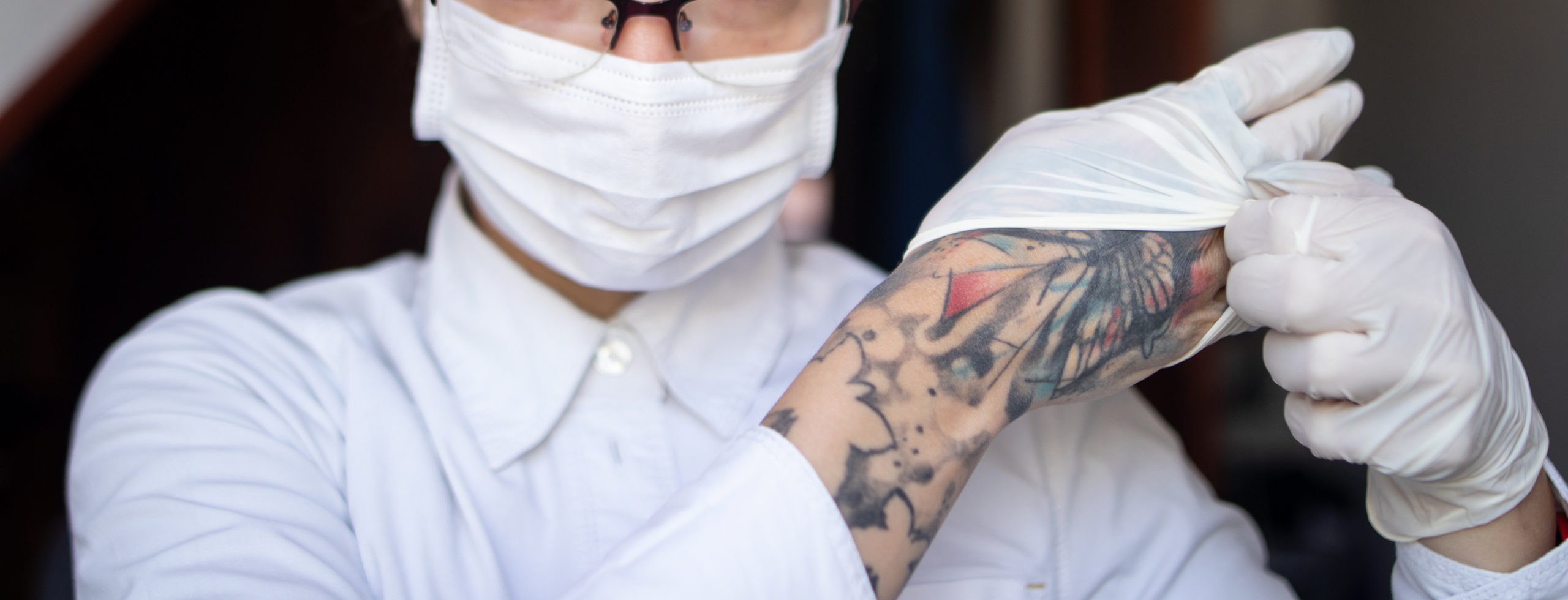Tattoos and nose piercings formerly symbolized youth rebellion, angst, and even criminal background. Now, there are grandmas with tattoos.
According to a Harris Poll, almost half of millennials and more than a third of Generation X’s population have at least one tattoo.
Therefore, the question isn’t whether nurses have tattoos and piercings. It’s whether they should cover them up.
For years, men rarely walked the hospital corridors in scrubs as nurses. We saw how that changed. Now, will nurses begin to openly show their–literal–colors and piercings within healthcare facilities?
Keep reading for a deeper dig into the subject.
Get job matches in your area + answers to all your nursing career questions

What Medical Professionals and Patients Say About Tattoos and Piercings
A recent Medscape poll of medical professionals discovered that almost 60% think it’s OK for clinicians to have tattoos. That said, over 60% believe there should be restrictions and 41% believed that tattoos should be covered up by work attire.
Most patients have a mental image of how a nurse should look. According to surveys, patients indicated that they felt nose and lip piercings were affiliated with lower competence and trustworthiness ratings by both patients and medical colleagues.
Regarding tattoos, patients rated tattooed healthcare providers lower than untattooed providers.
However, two things about that data: first, the researchers asked the participants how they felt about these clinicians based on photos. Also, these responses generally reflect regional bias.
In another study, patients received direct medical care from clinicians with tattoos or piercings. Of the participants surveyed, ratings were unaffected by body art.
Additionally, a study of patient preferences at 10 academic medical centers discovered that patients preferred formal physician attire. However, regional differences made a difference. Southerners preferred formal attire over northeasterners.
Potential Benefits Nurses Displaying Body Art
Given the data, it’s hard to come to a definitive conclusion about body art. That said, there are definite benefits and drawbacks to displaying body art as a nurse.
- Builds a bridge: When nurses display body art, it can help their patients relate to them. It shows that they are individuals and might put the patient more at ease with the nurse. Given that many patients have tattoos, it could help to have nurses who look like them.
- Breaks down stereotypes: As mentioned, many stereotypes exist for people who display tattoos or piercings. By allowing nurses to display tattoos openly, it helps remove the stereotype.
- Children sometimes are drawn to tattoos: Often, when children come to hospitals, they are scared and anxious. Seeing a nurse with tattoos and piercings might quiet their anxiety and help divert their attention away from the immediate issue.
Drawbacks to Nurses Having Tattoos and Nose Piercings
- Assumed criminal background: As mentioned, years ago, people associated tattoos and piercings with criminals. These days that has changed. However, there are still a lot of people out there who make those associations.
- Unhygienic: Some people may look at tattoos and piercings as dirty. Though modern tattooing and piercing are sanitary, people may view them in another light altogether.
- Offensive: Some patients might find themselves offended by the presence or nature of the tattoo. For example, if the tattoo displays any nudity or vulgar statements, it could have a negative impact on patients. If you have an offensive tattoo or something that could be perceived that way, it’s best practice to try and conceal it as best you can.
Are There Rules Regarding Tattoos and Piercings?
Currently, body art policies are up to nursing schools and hospitals. Some facilities make you cover up your tattoos with long-sleeved shirts and remove piercings altogether.
Other institutions may allow tattoos, but only on specific areas of the body.
Nursing schools tend to be less lenient when it comes to body art.
What’s Best Practice?
If you’re a nurse considering getting body art, consider the following: location, size and content. For example, when it comes to getting a new tattoo, it’s important to get one that isn’t too large and can’t be covered up if necessary by scrubs.
Additionally, it’s important to pick a location that isn’t too distracting for staff and patients. Places like your face, neck, and hand are potentially bad locations to place a tattoo.
Last, make sure that you get a tattoo that isn’t vulgar or offensive in anyway.
If you already have a tattoo or piercings, consult your nursing school or hospital’s policies to understand better what you should do.
There’s a lot of gray areas when it comes to whether or not nurses can have nose piercings or tattoos. However, things are starting to change, and the pendulum is swinging as the populations’ norms adapt, so do the nursing populations norms and standards.
If you are a nurse with tattoos and a stellar resume, looking to re-locate to a more accepting facility, sign up here!
Incredible Health offers nurses an opportunity to find the job of their dreams.
Get job matches in your area + answers to all your nursing career questions

